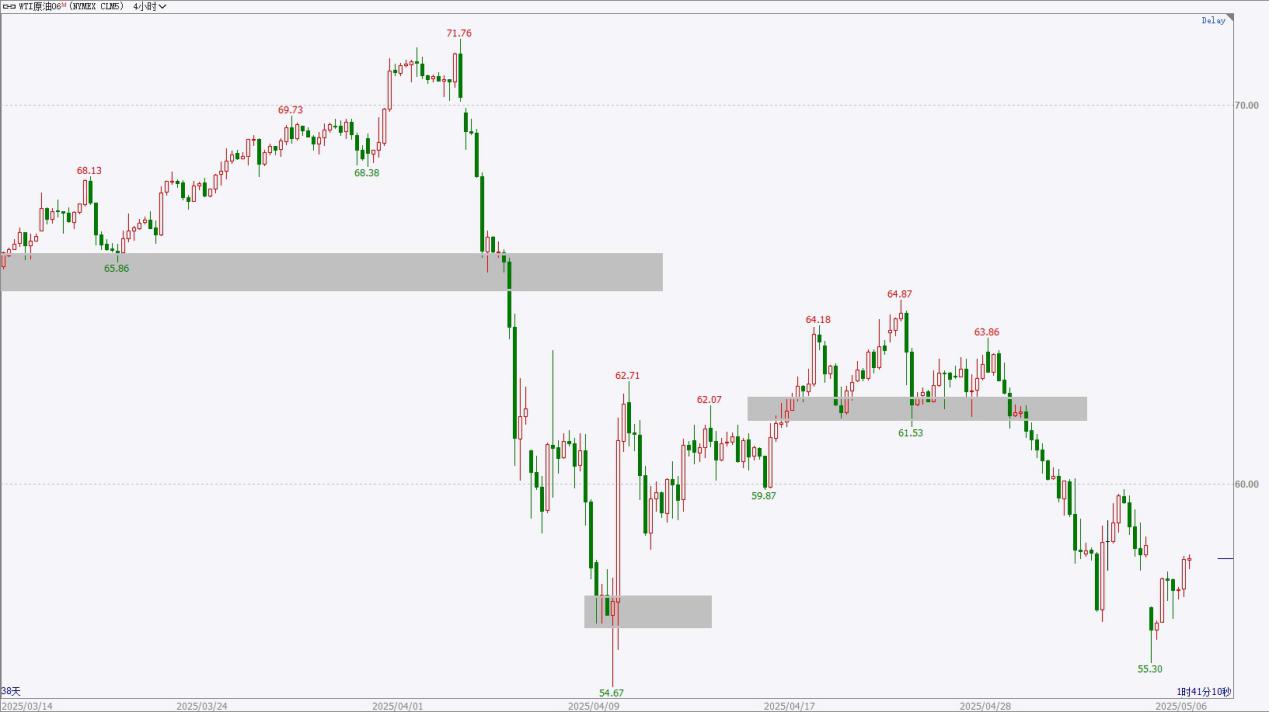|
Time
|
Data and Events
|
Importance
|
|
To be determined
|
The European Central Bank holds a central bank forum until May 7.
|
★★★
|
|
13:45
|
Switzerland’s adjusted unemployment rate for April
|
★★★
|
|
14:45
|
France’s industrial output month-on-month for March
|
★★★
|
|
15:50
|
France’s final services PMI for April
|
★★★
|
|
15:55
|
Germany’s final services PMI for April
|
★★★
|
|
16:00
|
Eurozone’s final services PMI for April
|
★★★
|
|
16:30
|
UK’s final services PMI for April
|
★★★
|
|
17:00
|
Eurozone’s PPI month-on-month for March
|
★★★
|
|
20:30
|
US trade balance for March
|
★★★
|
|
22:00
|
US global supply chain pressure index for April
|
★★★
|
|
23:45
|
US President Trump meets with Canadian Prime Minister Carney
|
★★★
|
|
Next day
00:00
|
EIA releases the monthly short-term energy outlook report
|
★★★
|
|
Next day
01:00
|
US 10-year Treasury bond auction yield as of May 6
|
★★★
|
|
US 10-year Treasury bond auction bid-to-cover ratio as of May 6
|
★★★
|
|
Variety
|
Viewpoint
|
Support range
|
Resistance range
|
|
US Dollar Index
|
Weak oscillation
|
96-97
|
100-101
|
|
Gold
|
Strong oscillation
|
3250-3270
|
3380-3400
|
|
Crude oil
|
Weak oscillation
|
55-56
|
65-66
|
|
Euro
|
Strong oscillation
|
1.1250-1.1300
|
1.1600-1.1650
|
*Pre-market views are time-sensitive and limited, are predictions only, for reference and learning purposes, do not constitute investment advice, and operational risks are borne by the individual. Investment carries risks; trading requires caution.
Fundamental analysis:
In the March meeting, the Federal Reserve maintained interest rates, the labor market remained stable, raised inflation expectations for this and next year, and lowered GDP growth expectations for the next three years. Starting in April, the pace of balance sheet reduction will slow, and there is uncertainty regarding tariff policies. In April, non-farm data showed an increase of 177,000 jobs, slightly exceeding expectations, with the unemployment rate remaining unchanged, indicating a robust labor market. Tariff policies increase market risks and uncertainties. The unadjusted CPI year-on-year for March slightly decreased, and expectations for interest rate cuts have risen.
Technical analysis:

The US Dollar Index has recently continued a volatile trend, with a general lack of strength in short-term rebounds, maintaining a low-level oscillation pattern, and no significant stabilization signs have appeared. Currently, it is at a minor pressure level, and attention should be paid to whether this pressure structure can break through. Overall, prices have retreated from high levels, breaking important support areas, and no stabilization signs have emerged. The upper pressure area is around 100-101, while the lower support area is around 96-97.
Viewpoint: Weak oscillation, signs of slowing decline, and short-term oscillation may continue.
*Pre-market views are time-sensitive and limited, are predictions only, for reference and learning purposes, do not constitute investment advice, and operational risks are borne by the individual. Investment carries risks; trading requires caution.
Fundamental analysis:
Geopolitical conflicts in the Middle East continue to escalate, and there is uncertainty in the situation in Eastern Europe. The European Central Bank’s interest rate decision in April saw a consecutive sixth rate cut of 25 basis points, with inflation easing smoothly and economic resilience strengthening. The Federal Reserve’s interest rate decision in March remained unchanged, the labor market is stable, and GDP growth expectations have been lowered, indicating a slowdown in the pace of balance sheet reduction. In April, U.S. non-farm payroll data showed that the number of new jobs exceeded expectations, and the unemployment rate remained unchanged; the year-on-year CPI for March slightly decreased, raising expectations for a Fed rate cut. U.S. tariff policies may stimulate the safe-haven attributes of gold.
Technical analysis:

Gold prices rebounded strongly last week after hitting a low, showing signs of continued upward movement in the short term, with prices approaching resistance areas and no signs of weakening. If there are long positions, it is advisable to take profits at highs; if there is a clear breakout of this structure, prices may continue to strengthen. From a larger cycle perspective, the upward structure is maintained, with signs of price stabilization after a pullback, and short-term testing of upper resistance levels. The upper resistance level is around 3380-3400, while the lower support level is around 3250-3270.
Viewpoint: Fluctuating with a slight upward bias, approaching resistance areas; if there are long positions, take profits at highs.
*Pre-market views are time-sensitive and limited, are predictions only, for reference and learning purposes, do not constitute investment advice, and operational risks are borne by the individual. Investment carries risks; trading requires caution.
Fundamental analysis:
The April EIA monthly report maintains the oil production forecast for this and next year, slightly lowering global oil demand for this and next year; the OPEC monthly report slightly lowers the global economic growth forecast for this year and next, as well as the growth forecast for global oil demand; the IEA monthly report lowers the global oil demand growth forecast for 2025. The OPEC+ member countries’ meeting in early May will increase production in June, marking the second consecutive month of accelerated production increases. There is uncertainty in U.S. tariff policies, which may affect demand. Last week, EIA crude oil inventories saw a significant decrease, with recent data showing considerable volatility.
Technical analysis:

U.S. crude oil has recently shown weak performance, with short-term fluctuations trending downward, and prices have retested previous lows without showing signs of stabilization. It is not advisable to excessively pursue short positions; if there are short positions, it is advisable to take profits. In the short term, there may be a fluctuating market. Overall, crude oil has shown weak performance previously, with fluctuations at low levels and no signs of significant stabilization. The upper resistance area is around 65-66, while the lower support area is around 55-56.
Viewpoint: Fluctuating with a slight downward bias, prices are at relatively low levels; take profits on short positions at lows.
*Pre-market views are time-sensitive and limited, are predictions only, for reference and learning purposes, do not constitute investment advice, and operational risks are borne by the individual. Investment carries risks; trading requires caution.
Fundamental analysis:
The European Central Bank’s interest rate decision in April saw a consecutive sixth rate cut of 25 basis points, with inflation easing smoothly and economic resilience strengthening, relying on data, assessing progressively, and dynamically adjusting monetary policy stance while paying attention to trade situations. The Federal Reserve’s interest rate decision in March remained unchanged, raising inflation expectations and lowering GDP growth expectations, indicating a slowdown in the pace of balance sheet reduction. The U.S. non-farm employment figures for April slightly exceeded expectations, and the unemployment rate remained unchanged; the year-on-year CPI for March slightly decreased. The manufacturing PMI values for major Eurozone countries showed little change in April.
Technical analysis:

The euro price slightly retraced last week, showing a daily oscillating structure, currently still within a support area, with no signs of stabilization. In the short term, it may maintain a fluctuating market; if it clearly breaks below this structure, the market may turn weak. Overall, the larger cycle’s upward structure remains intact, with a short-term adjustment phase, focusing on the effectiveness of the support area. The upper resistance area is around 1.1600-1.1650, while the lower support area is around 1.1250-1.1300.
Viewpoint: Fluctuating with a slight upward bias, focusing on the effectiveness of the support area.
*Pre-market views are time-sensitive and limited, are predictions only, for reference and learning purposes, do not constitute investment advice, and operational risks are borne by the individual. Investment carries risks; trading requires caution.


Daily Reviews
Our award-winning team of analysts provides keen and insightful technical and fundamental analysis to understand daily market news and investment trading opportunities
HTFX Daily Forex Commentary 0506
Time
Data and Events
Importance
To be determined
The European Central Bank holds a central bank forum until May 7.
★★★
13:45
Switzerland’s adjusted unemployment rate for April
★★★
14:45
France’s industrial output month-on-month for March
★★★
15:50
France’s final services PMI for April
★★★
15:55
Germany’s final services PMI for April
★★★
16:00
Eurozone’s final services PMI for April
★★★
16:30
UK’s final services PMI for April
★★★
17:00
Eurozone’s PPI month-on-month for March
★★★
20:30
US trade balance for March
★★★
22:00
US global supply chain pressure index for April
★★★
23:45
US President Trump meets with Canadian Prime Minister Carney
★★★
Next day
00:00
EIA releases the monthly short-term energy outlook report
★★★
Next day
01:00
US 10-year Treasury bond auction yield as of May 6
★★★
US 10-year Treasury bond auction bid-to-cover ratio as of May 6
★★★
Variety
Viewpoint
Support range
Resistance range
US Dollar Index
Weak oscillation
96-97
100-101
Gold
Strong oscillation
3250-3270
3380-3400
Crude oil
Weak oscillation
55-56
65-66
Euro
Strong oscillation
1.1250-1.1300
1.1600-1.1650
*Pre-market views are time-sensitive and limited, are predictions only, for reference and learning purposes, do not constitute investment advice, and operational risks are borne by the individual. Investment carries risks; trading requires caution.
Fundamental analysis:
In the March meeting, the Federal Reserve maintained interest rates, the labor market remained stable, raised inflation expectations for this and next year, and lowered GDP growth expectations for the next three years. Starting in April, the pace of balance sheet reduction will slow, and there is uncertainty regarding tariff policies. In April, non-farm data showed an increase of 177,000 jobs, slightly exceeding expectations, with the unemployment rate remaining unchanged, indicating a robust labor market. Tariff policies increase market risks and uncertainties. The unadjusted CPI year-on-year for March slightly decreased, and expectations for interest rate cuts have risen.
Technical analysis:
The US Dollar Index has recently continued a volatile trend, with a general lack of strength in short-term rebounds, maintaining a low-level oscillation pattern, and no significant stabilization signs have appeared. Currently, it is at a minor pressure level, and attention should be paid to whether this pressure structure can break through. Overall, prices have retreated from high levels, breaking important support areas, and no stabilization signs have emerged. The upper pressure area is around 100-101, while the lower support area is around 96-97.
Viewpoint: Weak oscillation, signs of slowing decline, and short-term oscillation may continue.
*Pre-market views are time-sensitive and limited, are predictions only, for reference and learning purposes, do not constitute investment advice, and operational risks are borne by the individual. Investment carries risks; trading requires caution.
Fundamental analysis:
Geopolitical conflicts in the Middle East continue to escalate, and there is uncertainty in the situation in Eastern Europe. The European Central Bank’s interest rate decision in April saw a consecutive sixth rate cut of 25 basis points, with inflation easing smoothly and economic resilience strengthening. The Federal Reserve’s interest rate decision in March remained unchanged, the labor market is stable, and GDP growth expectations have been lowered, indicating a slowdown in the pace of balance sheet reduction. In April, U.S. non-farm payroll data showed that the number of new jobs exceeded expectations, and the unemployment rate remained unchanged; the year-on-year CPI for March slightly decreased, raising expectations for a Fed rate cut. U.S. tariff policies may stimulate the safe-haven attributes of gold.
Technical analysis:
Gold prices rebounded strongly last week after hitting a low, showing signs of continued upward movement in the short term, with prices approaching resistance areas and no signs of weakening. If there are long positions, it is advisable to take profits at highs; if there is a clear breakout of this structure, prices may continue to strengthen. From a larger cycle perspective, the upward structure is maintained, with signs of price stabilization after a pullback, and short-term testing of upper resistance levels. The upper resistance level is around 3380-3400, while the lower support level is around 3250-3270.
Viewpoint: Fluctuating with a slight upward bias, approaching resistance areas; if there are long positions, take profits at highs.
*Pre-market views are time-sensitive and limited, are predictions only, for reference and learning purposes, do not constitute investment advice, and operational risks are borne by the individual. Investment carries risks; trading requires caution.
Fundamental analysis:
The April EIA monthly report maintains the oil production forecast for this and next year, slightly lowering global oil demand for this and next year; the OPEC monthly report slightly lowers the global economic growth forecast for this year and next, as well as the growth forecast for global oil demand; the IEA monthly report lowers the global oil demand growth forecast for 2025. The OPEC+ member countries’ meeting in early May will increase production in June, marking the second consecutive month of accelerated production increases. There is uncertainty in U.S. tariff policies, which may affect demand. Last week, EIA crude oil inventories saw a significant decrease, with recent data showing considerable volatility.
Technical analysis:
U.S. crude oil has recently shown weak performance, with short-term fluctuations trending downward, and prices have retested previous lows without showing signs of stabilization. It is not advisable to excessively pursue short positions; if there are short positions, it is advisable to take profits. In the short term, there may be a fluctuating market. Overall, crude oil has shown weak performance previously, with fluctuations at low levels and no signs of significant stabilization. The upper resistance area is around 65-66, while the lower support area is around 55-56.
Viewpoint: Fluctuating with a slight downward bias, prices are at relatively low levels; take profits on short positions at lows.
*Pre-market views are time-sensitive and limited, are predictions only, for reference and learning purposes, do not constitute investment advice, and operational risks are borne by the individual. Investment carries risks; trading requires caution.
Fundamental analysis:
The European Central Bank’s interest rate decision in April saw a consecutive sixth rate cut of 25 basis points, with inflation easing smoothly and economic resilience strengthening, relying on data, assessing progressively, and dynamically adjusting monetary policy stance while paying attention to trade situations. The Federal Reserve’s interest rate decision in March remained unchanged, raising inflation expectations and lowering GDP growth expectations, indicating a slowdown in the pace of balance sheet reduction. The U.S. non-farm employment figures for April slightly exceeded expectations, and the unemployment rate remained unchanged; the year-on-year CPI for March slightly decreased. The manufacturing PMI values for major Eurozone countries showed little change in April.
Technical analysis:
The euro price slightly retraced last week, showing a daily oscillating structure, currently still within a support area, with no signs of stabilization. In the short term, it may maintain a fluctuating market; if it clearly breaks below this structure, the market may turn weak. Overall, the larger cycle’s upward structure remains intact, with a short-term adjustment phase, focusing on the effectiveness of the support area. The upper resistance area is around 1.1600-1.1650, while the lower support area is around 1.1250-1.1300.
Viewpoint: Fluctuating with a slight upward bias, focusing on the effectiveness of the support area.
*Pre-market views are time-sensitive and limited, are predictions only, for reference and learning purposes, do not constitute investment advice, and operational risks are borne by the individual. Investment carries risks; trading requires caution.
Latest Reviews
HTFX Daily Forex Commentary 0819
HTFX Daily Forex Commentary 0815
HTFX Daily Forex Commentary 0812
HTFX Daily Forex Commentary 0811
Choose a Trusted Broker for Trading
Over 300 employees worldwide, more than 1,000 products, top-tier liquidity